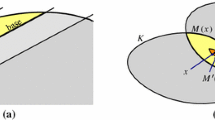Abstract
We prove the following sparse approximation result for polytopes. Assume that Q is a polytope in John’s position. Then there exist at most 2d vertices of Q whose convex hull \(Q'\) satisfies \(Q \subseteq - 2d^2\,Q'\). As a consequence, we retrieve the best bound for the quantitative Helly-type result for the volume, achieved by Brazitikos, and improve on the strongest bound for the quantitative Helly-type theorem for the diameter, shown by Ivanov and Naszódi: We prove that given a finite family \(\mathcal {F}\) of convex bodies in \(\mathbb {R}^d\) with intersection K, we may select at most 2d members of \(\mathcal {F}\) such that their intersection has volume at most \((c d)^{3d /2} {{\,\textrm{vol}\,}}K\), and it has diameter at most \(2d^2 {{\,\textrm{diam}\,}}K\), for some absolute constant \(c>0\).

Similar content being viewed by others
References
Artstein-Avidan, Sh., Giannopoulos, A., Milman, V.D.: Asymptotic Geometric Analysis. Part I. Mathematical Surveys and Monographs, vol. 202. American Mathematical Society, Providence (2015)
Ball, K.: An elementary introduction to modern convex geometry. In: Flavors of Geometry. Math. Sci. Res. Inst. Publ., vol. 31, pp. 1–58. Cambridge University Press, Cambridge (1997)
Bárány, I., Kalai, G.: Helly-type problems. Bull. Am. Math. Soc. 59(4), 471–502 (2022)
Bárány, I., Katchalski, M., Pach, J.: Quantitative Helly-type theorems. Proc. Am. Math. Soc. 86(1), 109–114 (1982)
Bárány, I., Katchalski, M., Pach, J.: Helly’s theorem with volumes. Am. Math. Monthly 91(6), 362–365 (1984)
Brazitikos, S.: Brascamp–Lieb inequality and quantitative versions of Helly’s theorem. Mathematika 63(1), 272–291 (2017)
Brazitikos, S.: Quantitative Helly-type theorem for the diameter of convex sets. Discrete Comput. Geom. 57(2), 494–505 (2017)
Brazitikos, S.: Polynomial estimates towards a sharp Helly-type theorem for the diameter of convex sets. Bull. Hellenic Math. Soc. 62, 19–25 (2018)
Dillon, T., Soberón, P.: A mélange of diameter Helly-type theorems. SIAM J. Discrete Math. 35(3), 1615–1627 (2021)
Dvoretzky, A., Rogers, C.A.: Absolute and unconditional convergence in normed linear spaces. Proc. Nat. Acad. Sci. USA 36, 192–197 (1950)
Fernandez Vidal, T., Galicer, D., Merzbacher, M.: Continuous quantitative Helly-type results. Proc. Am. Math. Soc. 150(5), 2181–2193 (2022)
Gordon, Y., Litvak, A.E., Meyer, M., Pajor, A.: John’s decomposition in the general case and applications. J. Differ. Geom. 68(1), 99–119 (2004)
Helly, E.: Über Systeme von abgeschlossenen Mengen mit gemeinschaftlichen Punkten. Monatsh. Math. Phys. 37(1), 281–302 (1930)
Ivanov, G., Naszódi, M.: A quantitative Helly-type theorem: containment in a homothet. SIAM J. Discrete Math. 36(2), 951–957 (2022)
Ivanov, G., Naszódi, M.: Functional John ellipsoids. J. Funct. Anal. 282(11), # 109441 (2022)
John, F.: Extremum problems with inequalities as subsidiary conditions. In: Studies and Essays Presented to R. Courant on his 60th Birthday, pp. 187–204. Interscience, New York (1948)
Naszódi, M.: Proof of a conjecture of Bárány, Katchalski and Pach. Discrete Comput. Geom. 55(1), 243–248 (2016)
Acknowledgements
This research was done under the auspices of the Budapest Semesters in Mathematics program. We are grateful to the anonymous referees for their valuable comments on the article.
Author information
Authors and Affiliations
Corresponding author
Additional information
Editor in Charge: János Pach
Publisher's Note
Springer Nature remains neutral with regard to jurisdictional claims in published maps and institutional affiliations.
The research of Gergely Ambrus was supported by NKFIH grant KKP-133819; by the EFOP-3.6.1-16-2016-00008 Project, which in turn has been supported by the European Union, co-financed by the European Social Fund; and by the national project TKP2021-NVA-09. Project no. TKP2021-NVA-09 has been implemented with the support provided by the Ministry of Innovation and Technology of Hungary from the National Research, Development and Innovation Fund, financed under the TKP2021-NVA funding scheme.
Rights and permissions
Springer Nature or its licensor (e.g. a society or other partner) holds exclusive rights to this article under a publishing agreement with the author(s) or other rightsholder(s); author self-archiving of the accepted manuscript version of this article is solely governed by the terms of such publishing agreement and applicable law.
About this article
Cite this article
Almendra-Hernández, V.H., Ambrus, G. & Kendall, M. Quantitative Helly-Type Theorems via Sparse Approximation. Discrete Comput Geom 70, 1707–1714 (2023). https://doi.org/10.1007/s00454-022-00441-5
Received:
Revised:
Accepted:
Published:
Issue Date:
DOI: https://doi.org/10.1007/s00454-022-00441-5




